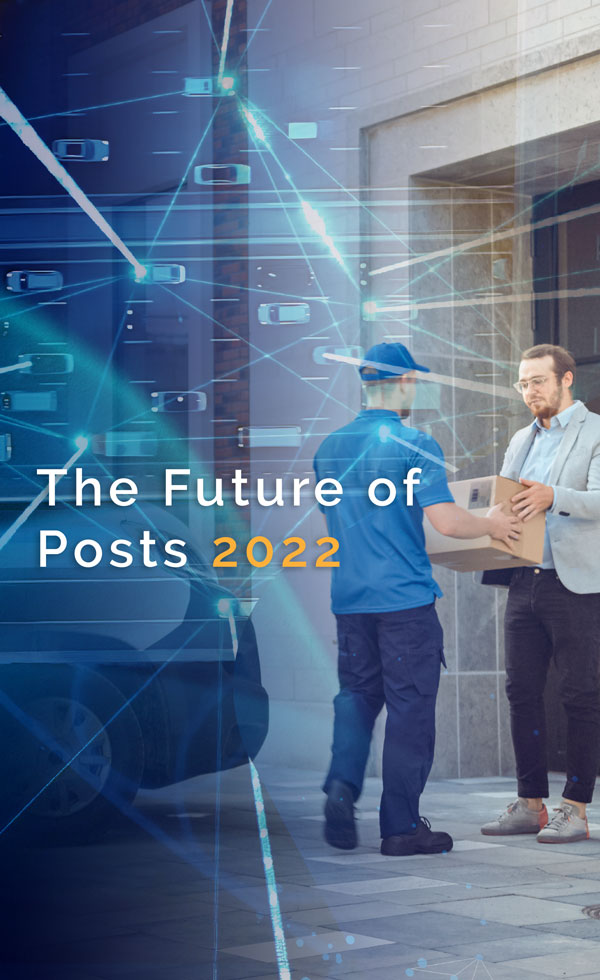




An interesting trend was uncovered in the Future of Posts 2022 report – a reversal of a concept: outbound to inbound. Last-mile delivery is still the top investment priority for postal operators, according to 41% of Posts. Refining this vital step in the process means staying open to and creating new delivery strategies, outbound and inbound.
Years ago, Posts delivered all items to the doorstep, such as letters and packages –we can refer to this as a Posts’ “outbound” strategy. Outbound deliveries to customers’ doorsteps or work sites will always have their value to Posts’ customers, but inbound opportunities add new dimensions to both customer service and cost savings. Further, exploring inbound retail options is a practical consideration in reducing Posts’ carbon footprint and costs and is a crucial way to offset the dependency on home delivery.
Conversely, we’re seeing a reversal towards more inbound strategies. For example, innovation in delivery today provides customers with a customizable last-mile delivery experience at the retail level. These options make it easy and attractive for customers to visit their local Posts to pick up packages and other items from convenient spots like the post office, PUDO locations, and smart lockers. For example, the Future of Posts research notes postal operators have placed 29% of their primary focus on PUDO last-mile delivery options.
This means customers never need to worry about sitting on their porches all day at risk of being stolen or damaged. Customers can monitor the packages with tracking features, and as soon as it’s at the inbound pickup center and processed, they can pick it up at their convenience. So the shift from outbound to inbound will certainly continue.
But a successful transition to a more inbound-focused Post requires the right foundation in place.
The lines between traditional delivery networks and retail networks are certainly getting blurred. An interesting detail uncovered this year how the retail network seems to be evolving for a couple of distinct reasons – to improve the customer experience and to support delivery. This explains the main drivers behind Posts’ investment decisions in their retail network.
73% of Posts believe that prioritizing an improved customer experience will create the greatest business value when deciding how to enhance POS channels. Reducing queues and wait times for service ranked second this year, with 36% of Posts indicating this as the best way to enhance channel value, with customer data analytics following with 14%. And while the top three are all linked to customer experience, it becomes easier to understand why Posts invest in one channel over another.
According to the survey results, Posts consider smart lockers an important channel now, but even more so in the future. Currently, 52% of Posts count smart lockers among their POS channel offerings. But moving forward, Posts plan to significantly boost their investment in smart lockers. 57% of Posts indicated they’ll be investing in this POS channel over the next one to three years — more than any other channel.
Additionally, PUDO is still viewed as an important POS channel now and in the future. 38% of Posts leverage PUDO channels today, according to the survey results, with 33% planning to invest more in this area over the next one to three years. Similar results were noted when we asked about self-serve kiosks, online stores, and mobile-in-store offerings. For example, 43% of Posts noted they’re using self-serve kiosks now, with 43% also planning to invest more in this important channel in the next three years.
With customer experience being an important factor in determining investment decisions, it’s easy to understand why Posts are looking to PUDO, self-service kiosks, mobile post-person technologies, in-store mobile and more. The convenience these channels offer customers is noteworthy, which also helps to explain why Posts also indicated future investments in areas like online stores (53%) start-at-home, finish in-branch services (28%), and drive-through-drive-up Post Office service (15%).
Overall, it’s clear that postal operators’ desire to ensure more convenient and accessible postal service locations is driving this improved access through third-party party partnerships with convenience stores, petrol stations, supermarkets, and so on. Additionally, convenience could also explain the focus on self-service and guided technologies, like kiosks, smart parcel lockers, mobile apps, in-store tablets and multi-purpose counter solutions that can be leveraged by clerks and customers. But a highly convenient and accessible retail network brings more opportunities for Posts than just an enhanced customer experience.
The omni-channel retail network supports growth in the e-commerce parcels business, enabling Posts to deliver more parcels because they now have more pick-up locations, more return options, fewer delivery stops, and more efficient routes.
When the customer experience and support for delivery become the driving forces influencing investment decisions, there are many resulting cost-efficiencies too. Self-service and opening new PUDO locations are both listed (in the top three) as the main retail network cost reduction initiatives Posts leverage.
Clearly, things are changing quickly, and supporting and investing in the right retail network POS channel mix is beneficial for improving customer experience, supporting growth in e-commerce, and reducing costs, to name but a few.
As the postal retail network continues to evolve, it will continue to create opportunities for Posts. Focusing on inbound strategies will no doubt create a better customer experience, drive greater cost efficiencies, and help manage parcel volumes, but these strategies are still dependent on the right mix of POS channels across the retail network. From this perspective, we see the retail network providing greater support and aligning more closely with the delivery network than ever before.
But there is one more area of focus for Posts that is changing the retail landscape. Increased e-commerce activity has resulted in more returns! And Posts that can make returns an effortless process for customers while keeping costs low will certainly achieve an advantage over the competition while alleviating parcel volume bottlenecks.
It’s clear that investments in reverse logistics are also rapidly changing the retail network. This explains why 63% of Posts offer alternative delivery locations, another 63% offer home pick-up, and 52% of Posts support “start at home, finish in branch” services — all to support the rise in parcel returns.

For more insights on what the future holds for postal operators, but sure to download the Future of Posts 2022.
